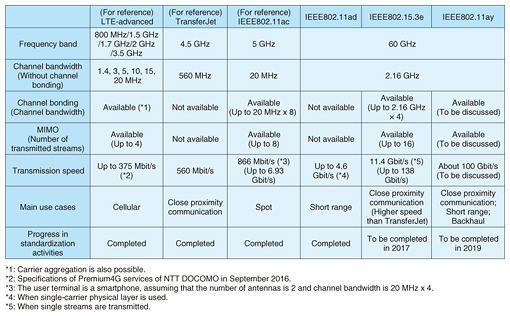 |
|||||||||||||||||||||||||
|
|
|||||||||||||||||||||||||
|
Feature Articles: Wireless Access Technology to Meet Diverse Needs from IoT/M2M to Broadband Vol. 15, No. 3, pp. 27–32, Mar. 2017. https://doi.org/10.53829/ntr201703fa5 A Study on Wireless Technologies to Improve Communication Performance by Utilizing Multi-frequency BandsAbstractThe wireless access network for the Internet of Things must offer ultra-broadband communication in order to transfer broadband data such as video data to be displayed for user assistance. High-reliability and low-latency communication is also necessary to remotely and automatically control the instruments of vehicles and robots in real time. This article describes our study on wireless technologies designed to achieve ultra-broadband, high-reliability, and low-latency communications by utilizing new frequency bands. Keywords: ultra-broadband, high-reliability/low-latency, multiband 1. IntroductionThe Internet of Things (IoT) is expected to enable numerous applications including machine-to-machine (M2M) narrowband applications such as smart metering and environment sensing. It is also expected to enable M2M broadband applications such as utilization of stored video data for maintenance of outdoor infrastructures, as well as vehicle control and M2M control applications such as remote control of instruments. For example, to analyze driving data captured by cars as big data in cloud servers, an ultra-broadband wireless access system is necessary to achieve sufficiently short data transfer speeds. Moreover, high-reliability and low-latency communication will be required for autonomous vehicle driving systems that can respond to the environment surrounding the vehicle and control the vehicle in real time. This article describes a study on wireless technologies that promise the ultra-broadband, high-reliability, and low-latency communication desired for the IoT. 2. Ultra-broadband wireless access systemIn this section, we explain the use cases, frequency band details, and specifications of the ultra-broadband wireless access system. 2.1 Use casesExamples of leveraging ultra-broadband data are considered below and depicted in Fig. 1.
(1) Batch transfer of log data: broadband log data such as driving data of cars and video data recorded outdoors are transferred to the cloud network. (2) Gathering information on the surrounding environment: information needed for automatic vehicle and robot control such as three-dimensional (3D) maps and pedestrian positioning information is provided from cloud servers just in time. (3) Downloading rich content: rich content such as movie data and games is downloaded to user mobile devices when needed so that users can enjoy it without accessing the Internet, for example, on planes. In these use cases, log data and database information saved on disk must be exchanged between the cloud database and the user anywhere and anytime through wireless networks. This requires disk-to-disk (D2D) communication, which until now has mainly been used to back up data on hard disks, between multiple devices and instruments that are far from each other through wireless networks. We set the target wireless transmission speed for this new D2D communication to 100 Gbit/s, which is 10 times faster than Wi-Fi*1. 2.2 60-GHz unlicensed bandWe have adopted the 60-GHz unlicensed band as the frequency band for wireless transmission speeds of 100 Gbit/s. This unlicensed band has the advantage of easily forming ultra-high-speed wireless access links because the wireless access points can be placed freely, and the wireless function can be installed on any device without a license. The characteristics of the 60-GHz band are described below. (1) Broadband bandwidth of more than 1 GHz (2) High antenna directivity (antenna size is several centimeters) (3) Short communication range (greater propagation loss and shielding than the microwave band) The large bandwidth makes it possible to achieve the maximum transmission speed of 11.4 Gbit/s with a single stream [1]. For reference, the transmission speed of Wi-Fi is less than 1 Gbit/s [2]. By applying multiple-input multiple-output (MIMO) techniques, a transmission speed of 100 Gbit/s can be expected. While the short communication range results in smaller communication coverage than that of the microwave band, the high antenna directivity enables interference signals from other stations to be reduced by both propagation loss and antenna directivity. Therefore, a stable wireless transmission speed of 100 Gbit/s is expected regardless of the other stations. To achieve a transmission speed of 100 Gbit/s in the 60-GHz band, more than ten streams must be simultaneously transmitted via space division multiplexing because the maximum transmission speed with a single stream is 11.4 Gbit/s. We consider short range MIMO to be one of the most promising approaches to meet the requirements. The system image is shown in Fig. 2.
The MIMO technique is often used in multipath-rich environments, and with space division multiplexing, the number of streams can equal the number of multipath waves. However, general MIMO techniques cannot support more than ten streams because it is difficult to ensure more than ten multipath waves regardless of the propagation environment. The short range MIMO technique is used in very close proximity environments in which the direct propagation path lengths between transmitter and receiver antennas are different from each other. The multiple streams can be simultaneously transmitted on direct paths by utilizing different phases on the propagation paths. When the linear antenna array is adopted as the MIMO antenna configuration, the carrier-to-interference ratio (CIR)*2 degrades as the number of multiple streams increases. Moreover, the CIR strongly depends on the relative positioning of the transmitter and receiver, so the CIR significantly degrades when the positioning is not optimum. To solve these problems, we are studying the use of two-dimensional antenna arrays and multiple MIMO configurations, the optimal design of those configurations, and adaptive selection of the MIMO configuration depending on the number of multiple streams and the positioning relationship at the time of use. 2.3 Standard specifications in 60-GHz bandThe standard specifications in the 60-GHz band are introduced in this section. The key standards are listed in Table 1. IEEE802.15.3e is the next-generation standard specified by the Institute of Electrical and Electronics Engineers (IEEE). It has higher transmission speeds than TransferJet*3 [3], and its target use is close proximity communication. IEEE802.11ad offers a higher transfer speed than Wi-Fi [2], and IEEE802.11ay is the next-generation standard with higher transmission speeds than IEEE802.11ad [4]. The standard IEEE802.11ad was completed in 2013, but IEEE802.15.3e and IEEE802.11ay are still in progress. All standards adopt the channel bandwidth of 2.16 GHz. Channel bonding*4 and multiple stream transmission (with a MIMO function) will be standardized in IEEE802.15.3e and IEEE802.11ay. NTT Network Innovation Laboratories is active in contributing to IEEE802.15.3e and has proposed the MIMO function to achieve a transmission speed of 100 Gbit/s and a faster link setup of 0.2 seconds.
3. High-reliability and low-latency communicationsThe IoT is expected to support various social activities. Thus, high-reliability and low-latency communications will be demanded from the viewpoint of productivity and efficiency, especially in industrial fields. For monitoring and control systems in factories for example, the transfer of application data between servers and devices should be completed within the required time periods in order to acquire real-time sensing information from the field and to give appropriate feedback for control. Proprietary industrial Ethernet specifications such as Ethernet for Control Automation Technology (EtherCAT)*5, which combines a standardized physical layer and a proprietary MAC (media access control) layer, are available. Another approach that is progressing is Time-Sensitive Networking, which extends the present Ethernet specifications. In the automotive industry, automotive Ethernet standards are being discussed such as IEEE 802.3bw [5] for broadband low-latency communication for vehicle harnesses. Accordingly, wireless communications should match the expectations of high-reliability and low-latency communications. 3.1 Advanced ITSThe development of an advanced intelligent transport system (ITS) is continuing in Japan, and industry, government, and academia are promoting the development of autonomous vehicle driving technologies for 2030 [6]. Any autonomous vehicle driving system requires cooperative technologies such as predicting events using vehicle-to-vehicle/roadside wireless communications and artificial intelligence, as well as self-driving technologies such as collision avoidance using on- and off-board vehicle sensors. One cooperative ITS technology that has already been launched is the safe driving support service called ITS Connect, which uses the 760-MHz band in Japan. In North America and Europe, a similar DSRC (Dedicated Short Range Communications) service will be introduced in the 5.9-GHz band in the next several years. Both of these systems adopt IEEE 802.11p wireless local area network (LAN) standards [1] for vehicle-to-vehicle/roadside communications. Meanwhile, the development and standardization of cellular communication systems called LTE (Long Term Evolution) V2X [7] are also being discussed. Since LTE V2X can utilize the existing LTE cellular infrastructure, additional investment is minimal. As shown in the case of the autonomous driving systems, a variety of wireless communication technologies in both licensed and unlicensed bands is being studied. Of course, existing wireless LANs are also promising radio access technologies (RATs) for these systems. The characteristics or performance of wireless communications depends on the radio environments such as the frequency band, the RAT adopted, network infrastructure availability, terminal device position, and radio channel conditions such as whether there is interference. Here, it is assumed that access point 1 with RAT-a running on band A and access point 2 with RAT-b running on band B are available (Fig. 3). Even if RAT-a has good performance (such as transmission speed or latency performance) as a RAT, its actual communication performance (such as throughput) will fall dramatically due to the presence of many terminals, heavy interference, or obstacles in the channel. In contrast, RAT-b offers lower ultimate performance but is more consistent. This suggests that establishing more reliable radio connections requires the optimal RAT to be selected from several candidates according to the multiband radio environments.
3.2 Multiband propagation evaluation technologiesNTT Network Innovation Laboratories is promoting the study of multiband propagation evaluation technologies and applied wireless access technologies. An overview is shown in Fig. 4. First, the radio propagation characteristics for each band (channel) are evaluated by simulating radio intensity and arrival time of multipath waves. For this, we consider 3D data of buildings and objects around the access points and terminal devices (Fig. 4(a)). Then the propagation results are combined to permit network simulations of different RATs for each band. These can evaluate overall system parameters such as processing latency and packet loss characteristics, taking into consideration the connection density of devices and other interference effects (Fig. 4(b)). These evaluation results make it possible to design multiband wireless systems that make maximum use of multiple bands and the diversity in available RATs.
4. ConclusionThis article described work on wireless network technologies to realize ultra-broadband, high-reliability, and low-latency communication for the future IoT. For ultra-broadband capacity, short range MIMO techniques are being applied to achieve the wireless transmission speed of 100 Gbit/s in the 60-GHz unlicensed band. The effective use of multi-frequency bands and RATs is being investigated to achieve high-reliability and low-latency communication, and a study is underway on multiband propagation evaluation technologies and applied wireless access technologies. In the future IoT, both use-case scenarios and requirements will become more diversified. We aim to establish wireless technologies to meet these requirements. References
|
|||||||||||||||||||||||||










